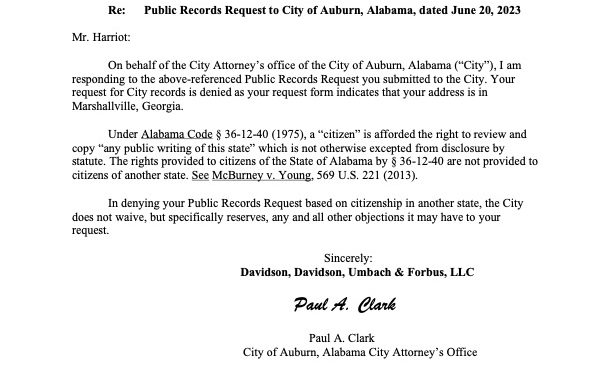Who killed Ricardo Gary?
OPINION: For months, theGrio has investigated how a wellness check turned into a deadly police encounter. At every turn, local, county and state law enforcement officials have refused to share any information that could solve the mystery. The post Who killed Ricardo Gary? appeared first on TheGrio.

OPINION: For months, theGrio has investigated how a simple wellness check turned into a deadly encounter with police in Auburn, Alabama. At every turn, local, county and state law enforcement officials have refused to share any information that could solve the mystery.
Editor’s note: The following article is an op-ed, and the views expressed are the author’s own. Read more opinions on theGrio.
Officially, no one or nothing killed Ricardo Gary.
Ricardo Gary was alive on Nov. 27, 2022, when he called his younger brother, Reggie Hall, to talk about “music, God and a lot of other religions.” He was alive when his daughters woke up and ate breakfast. He was alive when he took them to visit his mother a few blocks away. Gary was alive and in a good mood when visited with friends a few hours later. He was alive when he returned home and when his girlfriend called emergency services to ask for a wellness check.
Gary was alive when the first police officer arrived on the scene. He was alive when the second officer appeared and was still alive when a third and fourth police officers responded. The beloved father, son and brother was alive when the cops tased him the first time, when they handcuffed him, when they sat on top of him and when they tasered him again.
Then, 32-year-old Ricardo Gary was dead.
Since 2015, the Washington Post has logged every person shot and killed by on-duty law enforcement officers. But Gary did not die from gunshots, so his name does not appear on the “Fatal Force” database of police killings. He was never suspected of committing a crime, so he was not a “suspect” of any kind. There is no federal, state or local law that requires police to report when someone dies in their custody. Gary was pronounced dead after emergency medical service personnel arrived on the scene, so it wouldn’t have mattered anyway.
The story of how the Alabama native affectionately known as “Kardo” died is not uncommon. He was handcuffed and restrained just like 19-year-old Anton Black, who died “accidentally” after Greensboro, Md., police officers sat on his chest for six minutes. Responding officers tasered Gary multiple times, just as Williamsburg County, S.C., deputies did to 29-year-old Carl Edward Ballard. Gary is just one of hundreds of people who end up dead during an interaction with law enforcement officers every year even though they are not technically killed by police officers.
But the case of Ricardo Gary is also unique.
In most deadly incidents involving police brutality, including the previously mentioned cases, law enforcement agencies eventually provide an answer. Anton Black’s death was attributed to sudden cardiac arrest likely caused by “the stress of his struggle.” Authorities say Ballard died from cocaine ingestion, not because cops “employed a taser (conducted electrical weapon) several times before Ballard was subdued.” Then again, Minneapolis police officers said George Floyd died from a “medical incident.” NYPD officers initially said Eric Garner’s death was “not a big deal” because he died from cardiac arrest, not from Officer Daniel Pantaleo’s chokehold.
But in the strange case of Ricardo Gary, there is no cover story. Police did not excuse their behavior by saying Ricardo Gary made them “fear for their lives.” Investigators did not allege that Gary died from a justifiable use of force. Medical examiners did not blame Gary’s death on drug use or a faulty heart. Neither the Auburn Police Department, the county coroner, the district attorney nor Alabama’s highest investigative agency has bothered to provide Gary’s family with a satisfactory answer for “Why is Ricardo Gary dead? “
They haven’t even provided an unsatisfactory explanation.
Ricardo Gary has no criminal record — not even a traffic ticket. When police arrived, Gary was not suspected of committing a crime. But that does not matter. Ricardo’s daughters deserve to know what happened to their father. His mother deserves to know who or what killed her son. Gary’s family wants to know who or what killed a healthy man with no history of health problems or drug use. The Auburn public safety officers should tell the public how a wellness check ended up making a model member of their community less safe.
In an attempt to solve this mystery, theGrio interviewed eyewitnesses, family members and medical experts. After eight months of investigating the incident, listening to audio reviewing documents, watching video, canvassing the neighborhood, talking to neighbors, filing public information requests and asking for interviews with law enforcement officials, we were left with more questions than when we began. Although we cannot account for every detail, the true-life tragedy of Ricardo Gary’s death is a three-act play defined by a trio of facts that are not in dispute:
- Ricardo Gary was alive.
- Ricardo Gary had an interaction with the Auburn Police Department.
- Ricardo Gary is dead.
Act One: The Alive Part
I still don’t know what happened to my child. Maybe I will never know. He’s gone, and I just want answers.”
— Carolyn Gary, mother of Ricardo Gary
According to interviews with Ricardo’s family, Ricardo Almons Gary seemed to be in good spirits when he showed up at his mother’s home with his daughters, Chelsea and Lauren, around 9 a.m. on Sunday, Nov. 27, 2022. When his mother left for church, Ricardo and his daughters hung out with his younger brother, Reggie, who was in town. Ricardo left around noon and returned to his nearby apartment, where he lived with his daughters and his girlfriend, Brandi Davidson.
After returning from a visit to the store, Ricardo left home again, this time alone. Video footage obtained by theGrio shows Ricardo arriving at a friend’s house who lived a few blocks away at exactly 12:51 p.m. At 1:49, he was still laughing and talking at the same location.
Less than an hour later, Gary’s girlfriend was on the phone with 911.
“Brandi called me and asked: ‘Have you seen Kardo?’” Carolyn Gary told theGrio. Brandi informed Carolyn and Reggie that Ricardo was acting strangely, so she went into another room and called 911 to ask for a “wellness check.” According to family members and neighbors who spoke with theGrio, Brandi opened the door and informed Ricardo that she had called the police, and Ricardo left walking.
In a police incident report reviewed by theGrio that was filed hours after Gary’s death, the first officer on the scene claims he was responding to a report of a “suspicious person.” However, a neighbor who witnessed the beginning of the end of Ricardo Gary’s life recounted a different version of the incident. “[The police officer] yelled out to Kardo but he had the wrong name, so Kardo didn’t say anything,” said the eyewitness. “Then [the officer] got on the radio and said ‘Ricardo Gary!’ That’s when Ricardo walked up to him. I don’t see how they can say someone is ‘a suspicious person’ if they know your name. Make it make sense.”
In accordance with Auburn Police Department protocol, the investigation into Gary’s death was handled by the Alabama Law Enforcement Agency’s (ALEA) investigative arm, the State Bureau of Investigation (SBI). The summary of Officer James Jones’ interview by SBI says Brandi “needed help because her boyfriend, Ricardo Gary, was acting irrationally and she was scared for her safety.” In all the documents reviewed by theGrio, no one involved accused Ricardo of violence, threatening anyone or committing a criminal act. Concerned for Ricardo’s safety, his mom and brother hopped in the car and drove a few blocks.
“We passed by Drake Middle School and saw paramedics and two police cars,” Carolyn recounted. “They had somebody on the ground, but I didn’t know who it was, so we kept riding. We went to Brandi’s house, and she told us he left walking. When we passed by the school again, we saw two more cars. I said: ‘Let me stop and ask the cops if they saw him.’”
The police officers said they had no idea what she was talking about. She went to the police station, who told her to check the hospital. Hospital workers suggested she talk to the police. Instead, Reggie and Carolyn returned to Ricardo’s apartment to see if he had returned. They found Brandi outside and the apartment encircled with crime scene tape.
“About eight o’clock, I got a call from his dad. He said ‘Carolyn, Kardo’s gone,” and I said: ‘He was with you? I’m looking for him right now.
“But that is not the gone he was talking about.”
Act 2: The Police Part
On this date at approximately 3:30 pm, APD Officers responded to 700 Martin Luther King, Jr. Dr. in reference to a suspicious person. Upon arrival, a foot pursuit ensued and the subject was tased. After the subject was placed in handcuffs, EMS responded and treated the subject for injuries sustained during the tasing and fall. While being treated, the subject became unresponsive and was transported to a local hospital, where he expired.
— Excerpt from a report by Alabama Law Enforcement Agency (ALEA)
According to interviews with the family, neighbors and the available evidence, police did not respond at 3:30 p.m. Authorities have refused our requests to review 911 recordings, but we could not find a single reference to a “suspicious person.” A medical examiner did not find any serious injuries “sustained from the tasing or the fall.” Officers say they treated Gary after he became unresponsive and tried to resuscitate him before he was transported to a local hospital.
Aside from those inaccuracies, the rest of the cops’ stories are probably true.
Through its attorney, the city of Auburn’s Public Safety Department denied theGrio’s Freedom of Information Act request for body camera video, dash camera footage, surveillance video, police reports, the 911 call and emails related to the death of Ricardo Gary. However, theGrio used eyewitness testimony, video footage, audio, descriptions of the police footage reviewed by Gary’s family and leaked documents to establish what happened after Brandi — who did not respond to theGrio’s request for an interview — called 911.
According to the police report, Brandi made the call to 911 at approximately 2:48 p.m. The family says the timestamp on the bodycam footage they reviewed shows 6-foot-four, 225-pound Officer James Jones arriving at Ricardo and Brandi’s apartment at 2:53 p.m. Jones exited the vehicle and spoke to Ricardo. After an exchange of words, Ricardo picked up a tree branch and jogged toward Jones, causing Jones to pull out his Taser. In the audio of Jones’ body camera recording obtained by theGrio, the officer does not seem to be overly aggressive or combative.
“Jones stated as Gary charged toward him, he drew his Taser and turned it on,” reads the summary of Jones’ interview with state investigators. “Ofc. Jones advised he believed Gary recognized the Taser and began saying ‘whoa, whoa, whoa,’ and retreated back across the street.” Ricardo asked if he was under arrest, pivoted and began walking in the opposite direction. Minutes later, two more officers arrived, parked in the lot of a nearby community center and began following Ricardo on foot from a distance. Then, two more officers arrived.
“I’m still trying to figure out what they were trying to do,” Hall told theGrio. “If they were trying to keep Brandi and the kids safe, why did they follow Kardo? He hadn’t committed a crime. If they were trying to make sure he was safe, why not wait until the ambulance came?”
The report notes that “the officer’s goal at this point was to try and get Gary to come and talk with them and see if he needed assistance,” followed by the officers asking him to “drop the stick and come talk to them.” Gary complied, dropping the branch and actually went to talk to the cops. “Gary put down the stick and walked towards Ofc. Clark, prompting Ofc. Clark to draw his pepper spray can and begin to shake it.”
The report continues:
Ofc. Jones stated as Sgt. O’Hara approached Gary with his hands up trying to calm Gary further, Gary reached down and picked up the stick. Sgt. O’Hara reached for it also and Gary came over the top with the stick and struck Sgt. O’Hara in the head. Ofc. Jones advised Gary then turned towards Sgt. Gaither who had his Taser drawn and on already.
[Special Agent] Thornton asked Ofc. Jones if when Gary initially had the stick and turned towards Sgt. Gaither if he rushed at him in an aggressive manner or if he made a move towards him. Ofc. Jones answered when Gary swung the stick at Sgt. O’Hara, Gary immediately followed through and turned toward Sgt. Gaither.
If Gary struck an officer with a stick, it was not on the footage shown to the family from a single bodycam. According to the state investigators, the officers did not report being injured. The family members, interviewed separately, recounted a different version of events.
“O’Hara ran up from behind and snatched the stick,” recalls Hall. “But Kardo was holding on too tight, and [the officer’s tug] spun him around. You can tell he was startled. And that’s when they fell to the ground.”
“You grabbed the stick!” Carolyn wailed as the family watched the video of Ricardo’s last moments. “They killed my baby! They meant to do it! I can see it with my own eyes! They killed him!”
“Why did you do that?” Hall asked as his mother wept. “Why? That is absurd.”
In both the officers’ and the family’s version of events, as well as our review of audio recorded during the family’s viewing of the bodycam footage, as Sgt. Patrick O’Hara grabbed the branch that Reggie was holding, another officer tased Ricardo, sending O’Hara and Ricardo to the ground. Two other officers piled on top of Gary to restrain him. Once Gary was handcuffed and restrained in leg irons in the prone position, at least two officers remained on top of him trying to apply a second set of handcuffs. As Gary pleaded for the officers to get off, they tased him again.
“Gary continued to struggle and resist while officers maintained control of him on the ground,” reads the summary of Jones’ interview. “Ofc. Jones stated Gary continued to kick at officers after he was handcuffed … during the handcuffing, Sgt. Gaither did apply a second cycle from the Taser to assist the handcuffing officers gain Gary’s compliance.” The ALEA review notes that at least two of the officers knew Gary was having trouble breathing. When Gary’s body went limp, the report states that the “officers were able to sit him up so he could breathe better.” That’s when the officers noticed something was wrong.
“Ofc Jones said as soon as Gary was sat up, he noticed Gary had “‘a thousand-yard stare.’”
The officers told investigators that they removed the Taser probes and began chest compressions before giving the unresponsive Gary a dose of Narcan. Also known as Naloxone, the spray is used by police departments across the country to reverse the effects of an opioid overdose. By this time, emergency medical technicians had arrived and administered a second dose of Narcan to Gary and transported him to a nearby hospital.
When investigators reviewed Jones’ bodycam footage, investigators undoubtedly heard the handcuffed, piled-on, restrained, twice-tasered father who officers wanted to “see if he needed some assistance,” narrating his own death.
“Y’all killing me,” gasped the suspect who was not accused of committing a crime. “Y’all gon’ kill me.”
Ricardo Gary was right.
ACT III: The “Gone” He Was Talking About
Under Alabama Code § 36-12-40 (1975), a “citizen” is afforded the right to review and copy “any public writing of this state,” which is not otherwise excepted from disclosure by statute. The rights provided to citizens of the State of Alabama by § 36-12-40 are not provided to citizens of another state.
In denying your Public Records Request based on citizenship in another state, the City does not waive, but specifically reserves, any and all other objections it may have to your request.
— Excerpt from a letter by Paul A. Clark, attorney for the city of Auburn, Alabama.
Who or what killed Ricardo Gary? That is the fundamental question that Gary’s family wants answered. Seeking transparency, the family has met with medical examiners, law enforcement officials, city attorneys and the City Council. At every turn, local and state officials have ignored, blocked or simply refused to answer the family’s questions.
ALEA’s report includes the medical exam and toxicology analysis from the state’s Department of Forensic Sciences, as well as summaries of the autopsy and the investigator’s interview with Officer Jones. ALEA does not indicate whether or not other officers were interviewed but notes that it reviewed video footage of the incident. According to the report, a medical exam determined:
- The coroner found “no history of a mental disorder.”
- Gary did not have any heart or respiratory problems.
- According to the toxicology report, Gary had small amounts of marijuana in his system. No other drugs were found.
- The cause of death is listed as “undetermined.”
Normally, either the Alabama attorney general or local prosecutors would use the ALEA investigative report to determine whether or not charges should be filed. But, because Gary’s cause of death is not listed, it would be nearly impossible to indict the officers present. In a meeting with the Gary family, Lee County District Attorney Jessica Ventiere informed the family that no charges would be filed because they had “no answers.” (Ventiere declined to comment for this story and referred theGrio to the city attorney.)
So how did Ricardo Gary die? Was it the Naxolone? The tasers? Did the 911 dispatchers fail to relay the correct information to the police? Did police use excessive force?
“The Narcan didn’t kill him,” explained Dr. Sulieman Wazeerud-Din, an emergency medical specialist practicing in Atlanta. “You can almost certainly rule out the Narcan — even if no opioids were in his system. I haven’t examined the body or seen the autopsy, but that’s just not one of the drug’s negative effects.” Wazeerud-Din noted that because of contributing factors, autopsies alone don’t always effectively determine a cause of death, adding:
“It’s not always as cut and dry as people think. For instance, if someone with cardiovascular problems has a heart attack after they’re tased multiple times … It’s like, which came first, the chicken or the egg? A medical examiner is looking for clues or signs of trauma. But, sometimes there are none. Sometimes people’s hearts just stop, like Damar Hamlin. Oh, wait … did you say he was face down? Handcuffed?
“You ever heard of prone restraint?” Dr. Wazeerud-Din asked. “This kinda sounds like that.”
Wazeerud-Din was talking about George Floyd. And Eric Garner. And David Baker. And Tanisha Anderson. And Mario Clark. According to a 2022 investigation by 9News, at least 132 people have died face down, handcuffed, while bearing the weight of police officers.
He was talking about prone restraint.
For at least 25 years, the Department of Justice has warned law enforcement agencies that restraining subjects face down while applying physical pressure to a person’s body can cause sudden death. Numerous states, including Illinois and Massachusetts, have banned schools from using the technique. Other agencies have issued policy recommendations banning prone restraint.
“We postulate that most atraumatic deaths during police restraint of subjects in the prone position are due to prone restraint cardiac arrest (PRCA), rather than from restraint asphyxia or a stress‐induced cardiac condition, such as excited delirium,” a study from the National Institutes of Health reads. “The prone position restricts ventilation and diminishes pulmonary perfusion. In the setting of a police encounter, metabolic demand will be high from anxiety, stress, excitement, physical struggle, and/or stimulant drugs, leading to metabolic acidosis and requiring significant hyperventilation.” The study explains that “[a]utopsy examinations in arrest‐related deaths may be unrevealing,” noting that “deaths in-custody often demonstrate little pathologic evidence of the cause of death and there are no diagnostic markers of asphyxial deaths.” One of the researchers put it more plainly:
“[Arrest‐related deaths] go unexplained, at least in any acceptable scientific sense.”
It is very possible that a review of the available footage, as well as an autopsy, could determine Gary’s cause of death. Maybe an outside medical examiner could solve the mystery. Perhaps the clues are on the bodycam footage or the surveillance tapes. Numerous medical and forensics experts were willing to review the evidence for theGrio, possibly solving the Gary family’s mystery.
Auburn refused.
“As an elected official, I am certainly mindful of the tragic loss of Ricardo Gary,” said Auburn Mayor Ron Anders in a public statement. “However, because of the threat of litigation against the city by Mr. Gary’s family, I’ve been advised — and we’ve all been advised by the city attorney’s office to not make any comment.”
Citing the legal definition of “citizen” in the state’s Freedom of Information Act law, the city of Auburn denied theGrio’s request for dashcam footage, bodycam recordings, surveillance footage and any other documentation relating to Gary’s death. The city also denied the family on the grounds that their request “seeks documents that are not public records and that are protected from disclosure,” noting that “Executive Order 734, issued by Governor Kay Ivey in January 2023…only applies to the Executive Branch of the Alabama state government and is not applicable to municipalities like the City of Auburn.”

Apparently, the city of Auburn doesn’t want to solve the mystery. Perhaps Auburn already knows the answer and doesn’t want to share it with the Gary family. After all, the technique has cost state and local police departments from around the country at least $145 million in settlements and verdicts.
“I just want to know why,” Hall told theGrio. “Why did they have to chase him? Why was he in handcuffs? What was the purpose of chasing him to restrain him? What were they going to do?”
For Carolyn Gary, there is no mystery. In a meeting with law enforcement officials, she reached her own conclusion on her son’s cause of death.“My son was alive,” she told theGrio. “And he should still be alive. But he ran into the police.
“Then, my son was gone.”

Michael Harriot is a writer, cultural critic and championship-level Spades player. His book, Black AF History: The Unwhitewashed Story of America, will be released in September.
TheGrio is FREE on your TV via Apple TV, Amazon Fire, Roku, and Android TV. Please down
The post Who killed Ricardo Gary? appeared first on TheGrio.












![Brandy and Monica Address Past ‘Confusion and Conflict’ While Announcing ‘That Boy Is Mine’ Joint Tour [Video]](https://www.lovebscott.com/wp-content/uploads/2025/06/3e4c19e4ced74fcca75359da112c255d_md.jpg.webp)